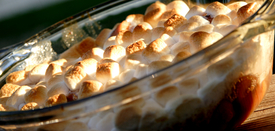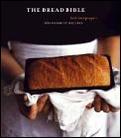Sweet Potatoes vs. Yams
Every Thanksgiving it's guaranteed that someone will ask, 'What's the difference between yams and sweet potatoes?" It seems most don't know and assume 'well, it's two different names so it must be different, right?' This has been my answer for many years. Well, this year I've decided to be the smarty pants.
The short answer is, this--yams and sweet potatoes are similar in that they grow underground and have orange flesh however each is botanically different from the other. The longer explanation is that yams are tropical vines of the genus Dioscorea and have a more reddish flesh. Large, starchy, and edible the tuberous roots can grow up to two even three feet long and weigh as much as 80 pounds. Sweet potatoes belong to the morning glory family and are native to the tropical areas of the Americas. There are two basic types of sweet potatoes: moist (orange-fleshed) and dry (yellow-fleshed). It's the orange-flesh version that is mistakenly called yams.
So what we are seeing in the markets, at least here in the States and Canada labeled as yams are actually sweet potatoes with relatively moist texture and orange flesh. Over at Straight Dope the following is offered:
"Contrary to what even some grocery store produce guys think, yams and sweet potatoes are unrelated vegetables, though in both cases you're eating the root of a tropical vine. Sweet potatoes, Ipomoea batatas ("batata" is the original Taino name, whence potato), are an American plant of the morning glory family, whereas yams are of the genus Dioscorea. Yams, which are rarely seen in the U.S. and Canada but are a staple in tropical regions, can grow up to seven feet in length. The name is thought to derive from the West African word nyami, "to eat," which is heard in Jamaican patois expressions such as, Oonu wan fi nyam banana dem?, 'Do you guys want to eat those bananas?'"
A scientific side-by-side comparison
by Beth Hensperger
Sweet Potato Biscuits
1 large sweet potato, baked and peeled (about 10oz.)
1 2/3 cup unbleached all-purpose flour
1 tblspn light brown sugar
2 1/2 tspns baking powder
1/2 tspn salt
6 tblspns cold unsalted butter, cut into small pieces
1/4 cup cold milk or heavy cream
Mash or puree the sweet potato pulp by hand, in a blender, or in a food processor until smooth for a total of 3/4 cup.
Preheat the oven to 425 degrees. Grease or parchment-line a baking sheet. In a bowl using a whisk or electric mixer, combine the flour, sugar, baking powder, and salt.
Using a pastry blender or two knives, cut the butter into the dry ingredients. The mixture will resemble coarse crumbs, with no large chunks of butter. If the butter gets very soft at this point, refrigerate the mixture to chill the butter. Add the sweet potato pulp and milk or cream, stirring just to moisten all the ingredients. The dough will be moist, then stiffen while stirring. It should be slightly shaggy, but not sticky.
Turn the dough out onto a lightly floured work surface and knead gently about 6 times, or just until the dough holds together. Roll out the dough into a rectangle no more than 3/4' thick. Take care not to add too much flour at this point or the biscuits will be tough. Cut with a floured 2" biscuit cutter, pushing straight down without twisting. Re roll the scraps to cut out additional biscuits.
Place the biscuits 1/2" apart on the baking sheet. Place the baking sheet on a rack in the center of the oven and bake 15 to 18 minutes or until golden brown. Let rest a few minutes and serve hot.


Nice, thank you. Now can you tell me the difference between squash and pumpkin??
I grew up calling the Japanese Kabocha pumkin(squash?) a pumpkin....but apparently it's a squash and not a pumpkin. Same goes with Potimarron, which according to the French is a Potiron (pumpkin) that tastes like Marron (chestnut) hence the name. So I've always thought of it as a kind of pumpkin...but I've heard it called Hokkaido Squash here. What gives?
I yearn for a simpler time in Bangkok, where pumpkins were always just pumpkins, and squash was a racket sport you play in a room with one wall made of plate glass!
xx
P
Posted by: Pim | November 22, 2006 at 08:22 PM
My wife and I have a wager. She says all pumpins are squash and I disagree. Can you please enlighten us and bring harmony back to the dinner table??
Many thanks,
Bruce
Posted by: bruce | March 22, 2007 at 09:37 AM